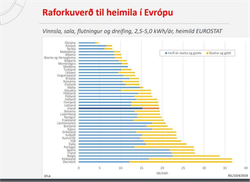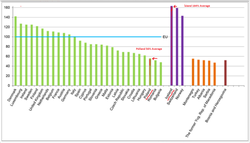Er hęgt aš setja VĶXLARANA į BEINANN RĶKISSTYRK, til aš žeir žurfi ekki svikafléttur, og aš koma sér inn ķ öll orku višskipti til aš taka tķfaldan toll, af orkusölunni. ????
Žegar žingmenn verša komnir meš orkupakkann, veršur žį fyrirtękjum eins og ENRON og fleirum leyft aš bśa til svikafléttur og gręša milljarša tugi dollara, eins og gert var ķ Kalifornķu, į UPPBOŠSMARKAŠINUM, og žaš sagši starfsmašurinn aš vęri löglegt.* ???????
Žį viršast žingmenn setja lög sem gera žetta löglegt.
https://www.wsws.org/en/articles/2005/02/enro-f09.html
000
Hvaša sęti ętli aš Ķsland hafi ķ kaupgetu į heimilisrafmagni.
Nś er fariš aš taka arš af raforkusölunni, kallaš til fjįrfesta.
Žegar žingmenn verša komnir meš orkupakkann, veršur žį fyrirtękjum eins og ENRON og fleirum leyft aš bśa til svikafléttur og gręša milljarša tugi dollara, eins og gert var ķ Kalifornķu, į UPPBOŠSMARKAŠINUM.?*
000
Er aš skoša rafmagnsverš og kaupgetu.
Žś įtt aš koma meš betri ašferš og leišrétta, koma meš einfalt og gott. Ég er ekki viss um aš ég höndli žetta rétt.
Til aš eitthvaš sé aš marka aš lesa žessa töflu um raforkuverš, žarf aš koma tafla um laun fyrir sömu rķki.
Takiš sem dęmi Macedoniu meš kaup mįtt, 44 og Ķsland meš kaupmįtt 164 (Žetta er kaupmįttar hlutfall)
Rafiš Macedonia 7 eša meš skatti 9 og Ķsland 16 eša meš skatti 18 ( žetta er eithvert hlutfall į raforkukostnaši į heimilum)
Žį veršur 1 ķ kaupgetu:
Macedonia 9/ 44 = 0,20 Ķsland 18/ 164 = 0,11
Er žį veršiš sinnum 10 til aš skija betur:
Macedonia ………….. 2,0 ………………. Ķsland 1,1
Macedonia greišir 100% Ķsland greišir 55% af žvķ.
Macedonia greišir nęr helmingi meira en Ķsland
klikka, mynd žį stęrri
1
2
000
*Enron defrauded California out of billions during energy crisis
https://www.wsws.org/en/articles/2005/02/enro-f09.html
By Jerry Isaacs
10 May 2002
Documents released Monday by the Federal Energy Regulation Commission revealed Enron Corporation deliberately created real and imaginary shortages during the 2000-2001 California energy crisis, in order drive up prices and reap vast profits in the state’s newly deregulated energy market.
Internal memos from the now bankrupt company outline the various schemes Enron executives used to defraud officials running the state’s power grid, manipulate energy supplies and literally loot the state treasury of billions of dollars. Throughout this period Enron enjoyed the closest political ties with the Bush White House, which rejected appeals from California officials for federal intervention and the imposition of price caps.
Residents in the country’s largest state suffered through six days of rolling blackouts in early 2001 following a tenfold increase in energy prices. The price hikes caused the bankruptcy and near-collapse of the two large utilities, leading to the layoff of thousands of workers and the wiping out of many small investors. In addition, state officials imposed severe budget cuts due to a rise in energy costs from $7 billion in 1999 to $27 billion in 2000, and after laying out $6 billion to buy daily power and another $40 billion to secure long-term contracts and stabilize the state’s energy supply.
Included in the documents was a memo written by an Enron staff attorney and an outside lawyer on December 6, 2000, the day after the state’s first near-blackout. Written apparently in anticipation of investigations and possible lawsuits against the company, the memo described trading strategies used to create the appearance of shortages or congestion, circumvent state pricing caps and in general exploit the anarchy of the market—which it helped create as one of the chief proponents of state deregulation during the 1990s. The strategies had such nicknames as “Fat Boy,” “Ricochet,” “Get Shorty,” “Death Star” and “Load Shift.”
One such strategy involved the company buying electricity from the California Power Exchange for $250 a megawatt-hour—the maximum allowed under state limits—and reselling it to states in the Northern Pacific for $1,200. Aware that this was contributing to a further shortage in California, the lawyers wrote, “This strategy appears not to present any problems, other than a public relations risk arising from the fact that such exports may have contributed to California’s declaration of a State 2 Emergency yesterday.”
According to the Los Angeles Times, Enron found a way to profit by playing each of the state’s two energy markets off one another. The first, a “day-ahead” auction market run by the California Power Exchange—the “PX”—was supposed to handle the bulk of electricity requirements. A second “real time” market was run by the California Independent System Operator (Cal-ISO), which was meant only to correct occasional imbalances. The latter became the source of vast profits from huge price swings.
Buyers and sellers in the real-time market were required to submit daily schedules of their production and their “load,” i.e., the amount of power their customers in the state required. While these two estimates were supposed to be roughly equivalent, according to the internal memo one of Enron’s key strategies—code-named “Load Shift”—was to deliberately overstate the amount of energy its customers required. When energy supplies were tight Cal-ISO would pay traders a premium for providing more power than was required. Enron would deliver the promised amount and would then be paid a premium price for removing their energy from the grid.
Enron also flooded the state’s transmission lines with more electricity than it could handle in order collect “congestion payments” from Cal-ISO to schedule energy transmission in the opposite direction or reduce their generation/load schedule. “Because the congestion charges have been as high as $750/MW [per megawatt], it can often be profitable to sell power at a loss simply to collect the congestion payment,” the memo said.
In a letter sent by the Federal Energy Regulation Commission, the agency’s investigators said the documents described how under the so-called Death Star strategy Enron’s traders were “creating, and then ‘relieving,’ phantom congestion” on the state’s power grid. According to the New York Times, the documents also detail what investigators described as “megawatt laundering,” in which Enron bought power in California—at lower capped prices—resold the power out of the state and then bought it back in order to resell it to California at a huge markup. By selling California “out-of-state” electricity, Enron could circumvent price restrictions on power bought inside California.
During and after the crisis Enron officials insisted they did nothing to exacerbate the situation. In an interview last year on the PBS “Frontline” program, Kenneth Lay said, “Every time there’s a shortage of a little bit of a price spike, it’s always collusion or conspiracy or something. I mean, it always makes people feel better that way.”
Bush administration officials repeated Enron’s claims that California’s problems were caused by the state’s “flawed” deregulation plan—which was not “free market” enough—and strict environmental standards, which limited the construction of new power plants. Bush and Vice President Dick Cheney publicly opposed price controls, insisting that any such moves would be a disincentive for power companies to operate in the state.
Several weeks after the memos were written outlining the company’s strategy to manipulate California’s market, Enron CEO Kenneth Lay—the largest single contributor to Bush’s political career—successfully prompted the Bush administration to appoint free-market advocate Pat Wood as the head of the Federal Energy Regulation Commission. Once in place, Wood resisted the implementation of price controls for months while the crisis spun out of control.
After FERC was finally pushed to restrict price hikes in late April 2001 Cheney denounced the move, telling the Los Angeles Times, “Price caps are not a help. They take us in exactly the wrong direction.” After reiterating that only free market policies could resolve California’s problems, Cheney added, “I’ve never seen price regulations that I’ve felt very good about. If I had been at FERC, I would never have voted for short-term price caps.”
At the time California’s Democratic governor and senators requested federal intervention to hold down the cost of electricity and charged that energy providers were manipulating the market to boost their profits. According to the New York Times, Senator Diane Feinstein said she tried “three or four times” to speak with Bush about the state’s crisis but the president refused to meet with her. Instead she held two brief meetings with Cheney as part of larger groups. “Their attitude was laissez-faire, let the market do what the market does, but it was a broken market,” she told the Times. At meetings with Cheney on March 27 and June 12, she said, the vice president spoke, “but did not listen much. When someone is looking at their watch, it gives you a pretty good idea they want to get out of the room,” Feinstein said.
Commenting on the fact that Enron’s chairman, Kenneth Lay, was given unrestricted access to the White House, Feinstein added, “Here is a company that was a ribald, as brash, as swashbuckling and as unethical as any company I can possibly conceive of. And they had major access to this administration. But the senior senator from California can’t get to see them.”
The Democratic senator has asked Attorney General John Ashcroft to “pursue a criminal investigation to determine whether in fact any federal fraud statutes or any other laws were violated.” But neither Feinstein nor any other Democrats have suggested that there should be a criminal investigation in the Bush administration’s efforts on behalf of the energy trader.
For its part, the US media, which spent the Clinton years giving credence to every right-wing campaign to destabilize the government—from Whitewater to the Monica Lewinsky affair—has also sought to downplay Bush’s ties to a company that wreaked havoc in California, defrauded its investors and threw thousands of workers out of work, while its executives made millions in compensation.
California officials are seeking to recover some of the $30 billion Governor Gray Davis says Enron “extorted from the state.” But that will be difficult because the company has filed for bankruptcy and sold off its energy-trading division. USB Warburg, the investment bank that bought the division in February, said it had no liability for any violations carried out by the former management. “We did not inherit the liabilities,” a spokesperson said.
Enron epitomizes the corruption that is so pervasive throughout corporate America and provides a glimpse of the anti-social methods used by the financial elite to accrue their vast personal fortunes during the stock market boom of the 1990s. It also shines further light on all the nostrums about deregulation and the “magic of the market.”
According to the memos, Enron was not alone in manipulating the state’s energy market. The Enron attorneys said other energy traders emulated Enron and even used the same shorthand names to describe the schemes they used.
A spokesman for an energy trading group told the San Francisco Chronicle that Enron methods were not criminal and in fact the company was just doing what everyone else was doing.
“They were probing different spots to see what worked,” said Gary Ackerman of the Western Power Trading Forum. “A lot of companies were doing that. Any time there is a complex system like the energy market, people are going to stick their finger in and see what works.”
“The whole reason for the existence of traders is to make as much money as possible, consistent with what’s legal,” R. Martin Chavez, a former head of risk management at Goldman Sachs told the New York Times.
“I lived through this: if you didn’t manipulate the market and manipulation was accessible to you, that’s when you were yelled at.”
Egilsstašir, 19.02.2019 Jónas Gunnlaugsson




 agny
agny
Bęta viš athugasemd [Innskrįning]
Ekki er lengur hęgt aš skrifa athugasemdir viš fęrsluna, žar sem tķmamörk į athugasemdir eru lišin.